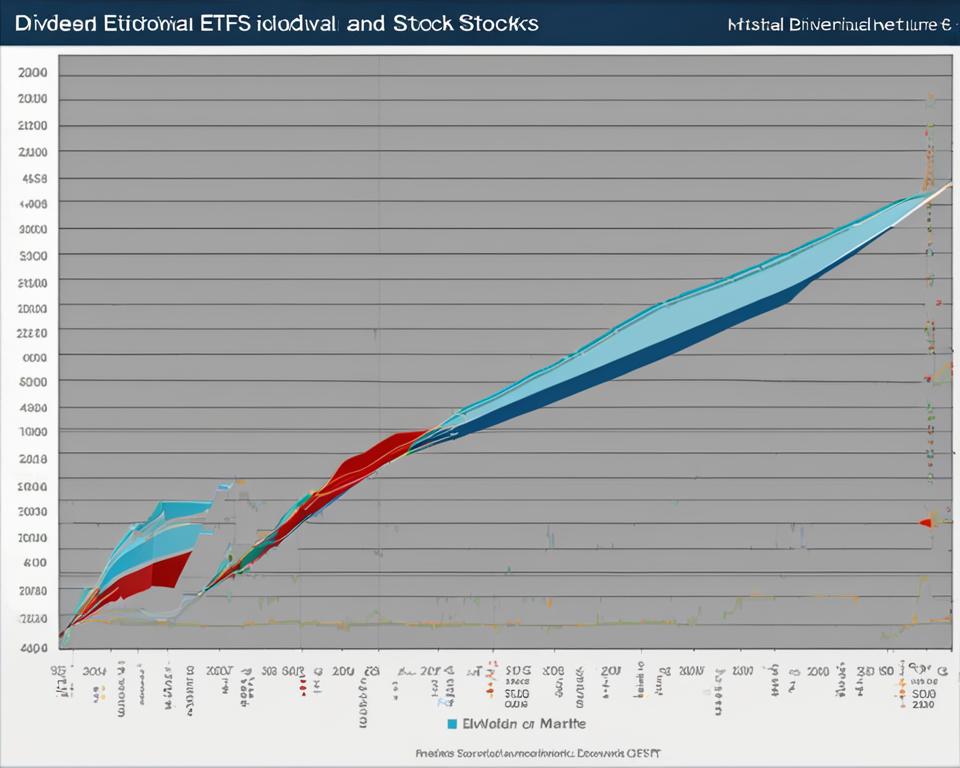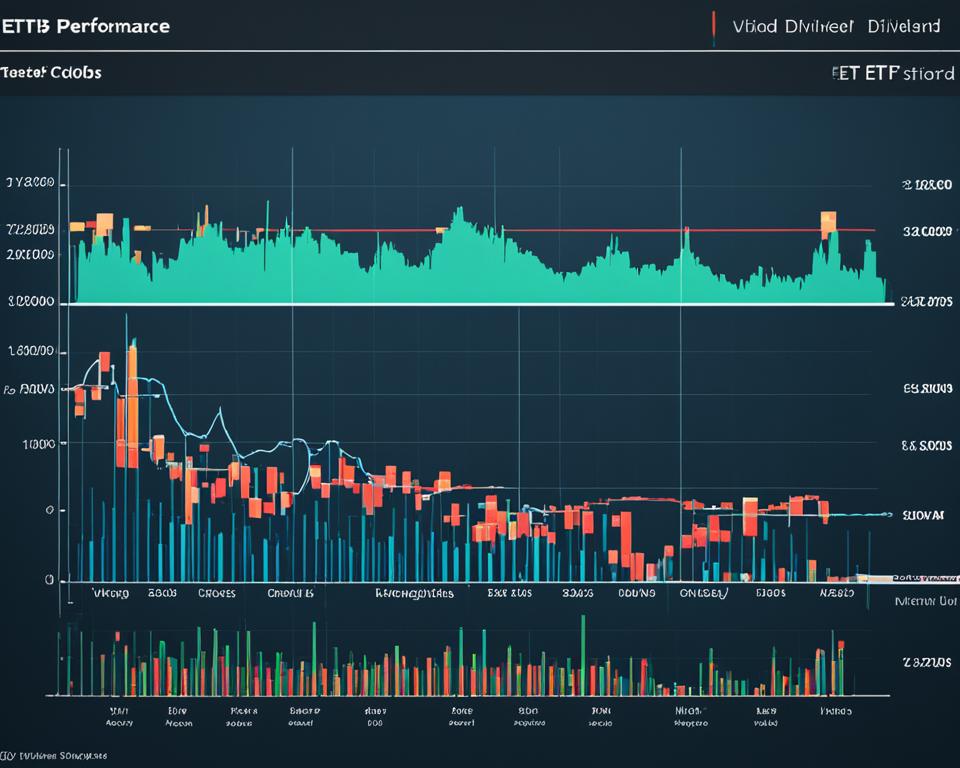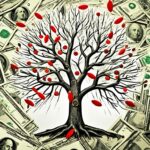When you’re navigating the ebb and flow of market volatility, understanding the nuances in the performance of dividend ETFs versus individual dividend stocks becomes paramount. A robust dividend ETF performance analysis reveals that in the tumult of fluctuating markets, these ETFs are structured to offer a semblance of stability. By allocating assets into diverse high-yielding stocks, dividend ETFs aim to provide you with a dependable source of income. This strategy often shields your investments from the mercurial tides that can unsettle individual stocks.
On the other side, holding individual dividend stocks can expose you to company-specific risks that may lead to sudden drops in value, demanding prompt and often arduous decision-making. Yet, they hold the potential for higher growth, albeit with increased volatility. The performance of dividend ETFs and stocks can therefore be significantly different, influencing the choices you make in crafting an investment portfolio tailored to your risk appetite and financial objectives.
Key Takeaways
- Dividend ETFs typically provide a cushion during market downturns, due to their diversified holdings.
- Dividend ETFs offer a steady income flow, which can be preferable for risk-averse investors.
- Individual dividend stocks can present greater growth opportunities compared to dividend ETFs.
- Company-specific risks associated with individual stocks can lead to higher volatility and investment risk.
- The choice between dividend ETFs and individual stocks should align with your income needs and growth ambitions.
- It’s crucial to conduct a comprehensive dividend ETF performance analysis to make informed investment decisions.
Understanding Dividend ETFs and Individual Stocks
As you construct your investment portfolio, it’s critical to comprehend the contrast between dividend ETFs vs individual stocks. Both serve unique roles in achieving diverse financial aspirations. What distinguishes them predominantly is how they function within your investment strategies, catering to distinct risk tolerances and income preferences.
Let’s break down the differences: Dividend ETFs are akin to a basket containing an assortment of high-yielding stocks, designed to dispense a steady flow of income. They offer you the convenience of instant diversification, which can help cushion against market volatility. Individual stocks, however, involve taking a more granular approach, providing ownership in a single entity with its distinct set of risks and rewards. This means potential for both dividend income and substantial capital gains.
A prime consideration is the hands-on effort required. Owning individual stocks involves actively tracking market trends and financial reports, ready to make swift decisions. In contrast, dividend funds vs individual stocks offer a more hands-off approach, appealing if you desire minimal involvement in daily investment activities while seeking consistent dividends.
The table below illustrates the attributes of each investment vehicle to help clarify their distinct advantages and functions as part of a balanced investment strategy:
| Investment Type | Income Potential | Growth Potential | Risk Level | Investor Involvement |
|---|---|---|---|---|
| Dividend ETFs | Consistent dividends | Stable, moderate growth | Lower due to diversification | Low (passive) |
| Individual Stocks | Varies by company | Higher, with greater volatility | Higher due to company-specific risks | High (active) |
Now, imagine you’re at the helm of a ship — dividend ETFs can be viewed as the steady current guiding your journey with less turbulence, while individual stocks are the gusts of wind that can rapidly propel you forward but also off course. Deciding which sails to hoist depends on your navigation style and destination — stability and income, or capital gains and hands-on command?
Ultimately, your choice between dividend ETFs vs individual stocks is influenced by your investment horizon, the level of active management you prefer, and the balance you wish to strike between earning potential and risk exposure. Both can play vital roles in forging a well-rounded portfolio aimed at achieving your long-term financial objectives.
Dividend ETFs vs Dividend Stocks: Overview and Key Considerations
As you weigh the options for reinforcing your portfolio with income-generating assets, dividend ETFs and individual dividend stocks each offer distinct pathways towards achieving your financial goals. In the panorama of investment opportunities, these pathways diverge depending on your objectives, risk tolerance, and desired method of income generation. Taking into consideration these criteria will support you in steering your investment journey effectively.
Investment Goals and Strategies
Dividend investing is pivotal in outlining your investment strategies. Should you favor a structured approach that targets reliable, regular income, especially during retirement, dividend ETFs constitute a sound choice. They provide a pooled investment experience, engaging with multiple corporations known for stable dividend payments. Conversely, if you seek dynamic growth and direct exposure to market swings, individual stocks offer a closer tie to the economic fortunes of singular entities, including the bonus of capital gains. Broad-based index investing, particularly tracking instruments like the S&P 500 via ETFs, amplifies this with diversified market exposure.
Risk Profile and Volatility Management
Navigating financial waters is contingent upon your risk tolerance and volatility management techniques. For conservative investors prioritizing stable investments, dividend ETFs can act as a buffer against turbulent market seas. Driven by their composition of financially solid companies, these funds typically ride out volatility with less fluctuation. In contrast, capitalizing on individual stocks spins a different tale—offering higher potential rewards but accompanied by increased portfolio volatility and company-specific risks that call for resolute risk management practices.
Income Generation: Dividends vs Capital Gains
The choice of how you generate income from your investments holds significant weight in this comparison. Dividend ETFs are tailormade for consistently dispensing dividend payments, which can be an appealing anchor for those who depend on this regular income as a financial lifeline. On the flip side, investing in individual stocks presents an alliance of dividend yield potential and the allure of capital gains, aligning with investors willing to engage with the unpredictability of the markets for greater financial rewards.
As you ponder dividend investing strategies, consider the following table as a compass for your decision:
| Investment Type | Income Attribute | Growth Attribute | Risk Attribute |
|---|---|---|---|
| Dividend ETFs | Regular, stable income | Moderate, consistent growth | Lower volatility, diversified risk |
| Individual Stocks | Variable, dependent on company | Potential for significant capital gains | Higher volatility, company-specific risk |
With this map in hand, you’re now equipped to chart a course through the sea of opportunities, ensuring that your sails are set towards your desired horizon, be it regular income through dividend payments or the adventure of capital gains for income generation.
Benefits and Limitations of Dividend ETFs
As you explore the advantages of dividend ETFs, it’s key to appreciate their role in offering a stable, regular income stream. These investment vehicles allow you to tap into the earnings of multiple companies with the purchase of a single ETF, harnessing the benefits of dividend ETFs over stocks when seeking diversification. Furthermore, should the dividends qualify, you could enjoy potential tax benefits, keeping more of your earnings in your pocket.
Less volatility is another attractive aspect of dividend ETFs, as they typically include shares from well-established, financially stable companies. This inherent stability can be reassuring during economic uncertainty, helping to smooth out the bumpy rides often experienced by individual stockholders. Yet, while these advantages enrich your investment experience, it’s equally important to be mindful of the limitations of dividend ETFs.
For instance, these ETFs may exhibit lower growth potential when pitted against the broader stock market indices. A singular focus on dividend-paying firms can lead to missed opportunities for heftier capital gains. Additionally, an uptick in interest rates might diminish the allure of your ETF’s dividends, as other income-generating assets become more competitive.
Moreover, certain dividend ETFs may have a penchant for channeling funds into specific sectors like utilities or consumer staples. While historically reliable for dividends, this can lead to a lack of portfolio diversification and heighten your exposure to sector-specific downturns. This concentration necessitates careful consideration of how such a strategic emphasis aligns with your broader investment goals.
| Advantages | Advantages Description | Limitations | Limitations Description |
|---|---|---|---|
| Regular Income Stream | ETFs provide dividends from a collection of stocks, offering consistent income. | Growth Potential | May lag behind market indices due to focus on dividend-paying stocks. |
| Potential Tax Benefits | Qualified dividends may be taxed at a lower rate than regular income. | Interest Rate Sensitivity | Dividends could be less attractive compared to other assets during rate hikes. |
| Lower Volatility | Investment in stable companies may protect against market swings. | Sector Concentration | Investments may be focused in specific industries, posing diversification risks. |
In conclusion, dividend ETFs stand as a formidable option for investors seeking a combination of income and stability. Yet, they are not without their drawbacks, particularly when growth and adaptability in a shifting economic environment are key. Aptly weighing these factors will guide you in customizing a portfolio that resonates with your financial outlook and risk appetite.
Diving Into the Performance of Dividend ETFs During Market Uncertainty
When faced with the unpredictability of market downturns, investors often look for a safe harbor in their portfolios—a role frequently filled by dividend-paying exchange-traded funds (ETFs). The resilience of these investment vehicles becomes critical as they encounter and weather the storms of volatile financial seas. In this segment, we delve into the performance of dividend ETFs, examining their robustness amidst market uncertainty that often leaves single stock holders wavering.
Market Downturns and ETF Resilience
During the trying times of economic cycles, dividend ETFs have historically demonstrated an impressive ability to absorb shocks, safeguarding your assets through diversification. With exposure spread across a broad array of sectors, these funds mitigate the risk and potential for fallout from any single company’s misfortunes. This built-in buffer has established dividend ETFs as a go-to for those looking to minimize their investment’s exposure to unruly market swells.
Dividend Stability and Predictability
Coveted for their ETF performance in volatility, dividend ETFs often deliver more predictable income and reliable dividends compared to the variable payouts of individual stocks. While individual companies may experience fluctuating fortunes—and consequently dividends—the total impact on an ETF’s distribution is often more muted, thanks to the balancing effect of its diversified portfolio.
Impact of Economic Cycles on ETF Performance
The waves of economic cycles can influence dividend payouts, possibly leading to dividend adjustments reflective of broader market health. For instance, a fund like the Vanguard High Dividend Yield ETF (VYM) may see ebbs and flows in payments through recessions and booms. However, the comprehensive nature of dividend ETFs tends to shield your portfolio from the more extreme vagaries suffered by individual stocks during such economic shifts.
To synthesize, while the surges of market activity can be daunting, entrusting your capital to dividend ETFs might lend a certain steadiness to your venture. As we continue to scrutinize their performance in volatility, these funds remain formidable contenders for inclusion in your investment strategy, especially when sailing through the choppy waters of economic unpredictability.
Performance Analysis: Dividend ETFs vs Individual Stocks
Choosing between ETF vs individual dividend stocks hinges on performance comparison that appreciates the balance of returns and risk. To illuminate this, consider both broader market behaviors and an individual sector’s agility. Dividend ETFs generally provide the advantage of diversity, shielding your portfolio from the intensity of market lows. Meanwhile, individual stocks could lead to higher gains during market rallies; yet, they bear the brunt of declines more abruptly.
Let’s dive deeper with a focus on dividend ETF vs individual stock returns. The varied holdings within an ETF can smooth out market fluctuations, somewhat insulating you from sharp portfolio value swings. Individual stocks might give a more thrilling ride on the performance rollercoaster, with the chance for steeper climbs, but also potentially precipitous drops. Below is a comparative breakdown to help distill these dynamics.
| Investment | Highlight Performance Scenario | Advantages | Risks |
|---|---|---|---|
| Dividend ETFs | Often stable during market volatility | Lower risk, diversified holdings | Muted upside during market rallies |
| Individual Dividend Stocks | Can excel in bull markets | High potential returns, capital growth | Greater exposure to company and sector risks |
The choice between these two avenues ultimately depends on your investment goals, risk profile, and whether you prioritize stability over high growth potential or vice versa. While individual dividend stocks keep you on the edge of your seat, dividend ETFs aim to offer a smoother ride over the long investment journey. Both can lead to prosperous destinations, but the paths are quite different, just like the experiences they offer.
Remember, performance comparison is not just about the highs and lows. It’s about how well the investment aligns with your financial objectives and the degree of involvement you wish to commit.
“dividend ETFs and funds perform compared to individual dividend stocks”
When you’re weighing your portfolio options, the performance of dividend ETFs and funds compared to individual dividend stocks is a critical consideration. Dividend ETFs amalgamate the returns of a variety of dividend-paying stocks, offering a mosaic of income streams that may mitigate the stark rises and dips associated with single stocks. The investment outcomes hinge on the financial goals you have set, whether leaning towards a predictable income or the excitement of capital growth.
Determining whether to tilt your investment portfolio towards dividend ETFs or individual stocks fundamentally depends on your comfort with market volatility and your financial aspirations. Do you seek the reassurance of a diversified fund that spreads risk across a swathe of companies, providing steady dividends? Or do you prefer the potentially high-yield, yet more volatile, path of selecting individual dividend stocks? Let’s analyze their distinctions to clarify your investment journey.
| Investment Type | Volatility Management | Income Potential | Capital Growth |
|---|---|---|---|
| Dividend ETFs | Lower volatility due to diversification | Consistent, reliable income | Moderate growth potential |
| Individual Dividend Stocks | Higher potential volatility | Dependent on company performance | Possibility of significant growth |

As portrayed in the above performance chart, the divergent paths of dividend ETFs and individual dividend stocks reflect their unique risk profiles and outcomes. You can see that dividend ETFs generally provide a layer of protection against the abrupt shocks that individual stocks may endure. This comes at the cost of possibly missing out on the high returns that individual stocks may achieve when they perform well.
The aggregate nature of dividend ETFs typically delivers a composite rate of return that irons out the extreme performances, either good or bad, of the individual stocks within its basket. For you, this could mean a smoother investment experience, especially meaningful if you’re planning for retirement or looking for stable passive income. On the flip side, selecting solid individual dividend stocks could be akin to placing strategic bets, where the wins might amplify your investment outcomes substantially but require active engagement and a higher risk threshold.
Ultimately, your decision to opt for dividend ETFs and funds or to carve out a portfolio of hand-picked individual dividend stocks should be informed by the investment landscape and your personal financial narrative. By doing so, you’ll be positioned to harness the strengths of each investment type while aligning with your overall wealth-building strategy.
Disadvantages of Dividend ETFs Relative to Individual Stocks
As you explore the suitability of dividend ETFs for generating passive income, it’s important to consider their potential drawbacks in comparison to individual stock investments. While dividend ETFs offer the convenience of portfolio diversification and professional management, they also come with certain disadvantages that merit your attention.
Limited Growth Potential and High Management Fees
One key concern is the limited growth potential inherent in many dividend-paying organizations. Such companies may allocate considerable profits to dividend distributions rather than reinvesting them into business growth. Due to this, dividend ETFs that focus on high dividend yield stocks may not experience the same capital appreciation as growth stocks. Furthermore, despite the often low management fees associated with passively managed ETFs, they can accumulate over time and detract from your investment returns, a cost not usually incurred when directly purchasing stocks.
Interest Rate Sensitivity and Tax Considerations
Dividend ETFs demonstrate distinct interest rate sensitivity. As interest rates climb, investors may turn to bonds and other assets offering higher incomes, potentially decreasing demand for dividend ETFs and affecting their market value. When considering ETFs for passive income, it’s imperative to remember the tax considerations. The dividends earned are subject to taxation, which can impact the net income you ultimately receive from your investment, sometimes at higher rates than long-term capital gains from individual stocks.
Sector Concentration and Portfolio Diversification
A common ETF disadvantage is sector concentration, which occurs when a fund invests heavily in particular industries with dependable dividends—often utilities or consumer staples. Such concentration can pose industry risks and reduce overall portfolio diversification, increasing vulnerability to industry-specific downturns. This can starkly contrast the broad market exposure you might achieve by selecting a diverse array of individual stocks or investing in an index fund that tracks a benchmark like the S&P 500.
| Aspect | Dividend ETFs | Individual Stocks |
|---|---|---|
| Growth Potential | Limited by focus on dividend payers | Higher potential linked to company performance |
| Management Fees | Low fees, but can reduce overall returns | No management fees |
| Interest Rate Sensitivity | Dividends may be less attractive during rate hikes | Less direct impact on stock prices |
| Tax Considerations | Dividends are taxable, affecting net income | Capital gains potentially taxed at lower rates |
| Sector Concentration | May lead to lack of diversification and higher risks | Can be mitigated by investor’s selection |
While dividend ETFs can serve as a viable path for those seeking regular income streams, acknowledging their limitations is essential in configuring a financial strategy that aligns with your goals. By weighing these factors, you can sculpt an investment approach that not only fosters passive income but also complements your aspirations for growth, risk tolerance, and financial efficiency.
Assessing Dividend Yields: ETFs vs Stocks
When embarking on the path of dividend investing, one of the essential aspects you’ll navigate is assessing dividends, particularly the dividend yields each option brings to the table. Dividend yields are a significant indicator of the income you can expect from your investments, hence the focus on their comparison is critical.
Understanding ETF yields can be somewhat simpler since they typically reflect a weighted average of the yields from their diversified holdings. This can often provide a more predictable income stream compared to individual stock dividends, which are subject to the financial health and dividend policy of the underlying companies.
Consider the historical context: during economic downturns, ETFs like Vanguard High Dividend Yield ETF (VYM) have demonstrated the tendency for dividends to fluctuate. Such variability is a critical factor if you’re relying on your portfolio for steady income. The historical performance data reveal that individual stocks may see more significant dividend cuts in tough economic times, whereas ETF dividends, although not immune, can be less volatile due to their diversification.
| Investment Type | Dividend Yield Characteristic | Income Predictability | Risk Factor |
|---|---|---|---|
| Dividend ETFs | Weighted average of multiple yields | More predictable | Lower due to diversification |
| Individual Stocks | Varies with company performance | Can be less predictable | Higher due to company-specific risks |
As you move forward in your investment journey, keep in mind that the allure of individual stocks with high dividend yields might be tempered by the knowledge that these yields can change based on how companies decide to allocate their profits. This highlights the importance of a thorough assessment process and staying informed about both broader market trends and individual company developments.
Whether you choose dividend ETFs for their diversification or individual stocks for their potential to offer higher yields, understanding and assessing dividend yields is paramount. It informs your investment choices and aligns your portfolio with your financial aspirations, all while you aim to navigate the dynamic seas of the stock market.
The Role of Market Capitalization in Dividend Investments
When it comes to building a steady flow of passive income through dividend investments, the size of the companies you invest in—reflected by their market capitalization—plays a significant role. Not only does it factor into the stability and predictability of the dividends paid, but it also influences the potential for growth within your investment portfolio.
Large Cap Stocks and ETFs
Let’s delve into the realm of large cap stocks, which typically boast a market capitalization exceeding $10 billion. These corporate giants are often industry leaders and have established a long history of robust financial performance. As a result, large cap stocks and the ETFs that invest in them are widely considered to offer more reliable and steady dividend investments. By channeling funds into ETFs like the SPDR S&P 500 ETF Trust (SPY), you’re aligning with some of the most formidable companies known for consistent dividend payouts, attributed to their solid earnings and substantial cash flows.
Investors seeking stability and a comparatively lower risk profile will find large cap ETF investment opportunities especially attractive. They serve as the financial bedrock for many investors, particularly those looking to maintain a reliable income stream with less exposure to market swings.

Small to Mid Cap Options for Dividend Investors
Turning to the more adventurous side of the spectrum, small to mid cap stocks present a different flavor of opportunity for the dividend investor. Generally, companies with a market capitalization between $300 million and $10 billion fall into this category. Although they may not have the same level of established business practices as their large cap counterparts, they frequently offer enticing dividend investor options with higher yields and significant growth potential.
The allure of investing in small to mid cap stocks or ETFs lies in their potential for both income and growth. These companies are often in the expansion phase of their business cycle, which can lead to a faster pace of dividend growth. The trade-off, however, is a higher level of volatility and a degree of unpredictability.
| Market Cap Classification | Typical Characteristics | Risk Profile | Dividend Yield | Growth Potential |
|---|---|---|---|---|
| Large Cap | Established, Steady Performers | Lower | Stable, Lower Yields | Moderate |
| Small to Mid Cap | Expansion Phase, Higher Volatility | Higher | Variable, Potentially Higher Yields | Significant |
If you’re willing to embrace a higher risk for a potential reward, a mix of small and mid cap holdings could provide the lucrative balance of dividend income and growth opportunities you’re seeking. The evolving landscape of these smaller caps can be rich with opportunities for those who diligently research and remain abreast of market trends.
How Dividend Reinvestment Shapes Long-Term Performance
Imagine you’re planting a tree. With proper care and time, what starts as a small seedling grows into a thriving tree. Similarly, dividend reinvestment works to foster the growth of your investments. By automatically channeling the dividends you earn back into purchasing more shares, you’re setting the stage for compounding returns, which can significantly amplify the growth of your portfolio over time. Whether you’re navigating the world of dividend ETFs or individual stocks, understanding the transformative power of reinvestment is key to unlocking enhanced long-term performance.
Now, let’s consider dividend ETFs. These funds often provide a seamless reinvestment mechanism known as a Dividend Reinvestment Plan, or DRIP. With DRIPs in place, the dividends you receive are automatically reinvested to purchase more shares of the ETF, thus leveraging the benefits of compounding without requiring you to lift a finger. This process can be a boon to your financial health, as the ease of automatic reinvestment encourages continuous growth and eases portfolio management.
On the other hand, if you hold individual dividend stocks, the reinvestment process may require a more hands-on approach. You have the flexibility to determine when and how much to reinvest, potentially tailor-seeking dividend reinvestment to specific strategic goals. Though it involves more effort, the personalized control over reinvestment decisions can align closely with your financial aspirations, market perspectives, and growth objectives.
Let’s break down the benefits of dividend reinvestment with a simple illustration:
| Year | Shares Owned | Annual Dividend | Shares Purchased (Reinvested) | Total Shares After Reinvestment |
|---|---|---|---|---|
| 1 | 100 | $4 per share | 4 | 104 |
| 2 | 104 | $4 per share | 4.16 | 108.16 |
| 3 | 108.16 | $4 per share | 4.33 | 112.49 |
As shown in the above table, even with a constant annual dividend, the number of shares you own—and consequently your dividends—increases each year due to the reinvestment. This illustrates the power of compounding; each reinvestment builds upon the last, driving the value of your holdings upward in a reinforcing cycle of growth.
Ultimately, whether you gravitate towards the simplicity of a dividend ETF’s automatic reinvestment or the deliberate control of reinvesting individual stock dividends, you’re employing a financial strategy that can transform your portfolio’s trajectory. By embracing dividend reinvestment, you’re setting yourself up for robust, reinforced long-term performance that could serve as the cornerstone of a solid financial future.
Strategies for Mitigating Risk with Dividend ETFs and Stocks
As an investor focusing on both growth and stability, understanding the significance of mitigating risk in your dividend-focused portfolio is crucial. Navigating the economic landscape requires a savvy blend of portfolio allocation and investment diversification. By spreading your investments across various asset classes, sectors, and market capitalizations, you can create a financial bulwark designed to withstand market fluctuations.
Dividend ETFs are particularly apt at providing diversified exposure to a swath of the market, naturally implementing mitigating risk measures by pooling a wide array of equities. In contrast, individual stock selection demands a more hands-on approach. Strategic rebalancing and meticulous selection are essential to achieve a level of diversification akin to that of dividend ETFs.
Portfolio Allocation and Diversification
At the core of a resilient investment strategy is a well-considered approach to portfolio allocation. By balancing your holdings among various dividend ETFs and stocks, you foster a protective shield against market downturns. This effort, when executed with precision, can safeguard your investments from severe loss and ensure a smoother financial ride.
| Investment Type | Role in Portfolio Diversification | Risk Mitigation |
|---|---|---|
| Dividend ETFs | Provides broad exposure, lessening the impact of any single stock downturn. | Spreads risk across a collection of dividend-paying companies. |
| Individual Stocks | Targets specific company growth and dividend potential. | Requires strategic selection to balance and maintain a diversified portfolio. |
The Effect of Economic Indicators on Investments
Keeping an eye on Economic indicators is another strategy for mitigating risk. Elements such as economic cycles, interest rate changes, and inflation levels can have profound investment effects. Staying attuned to these factors prepares you to anticipate and react to market responses, adjusting your investments in dividend ETFs and stocks accordingly to maintain your financial health.
| Economic Indicator | Potential Effect on Dividend ETFs | Potential Effect on Individual Stocks |
|---|---|---|
| Interest Rate Fluctuations | Can influence dividend yields and investor demand for ETFs. | May impact company capital costs, affecting profits and dividend payouts. |
| Inflation | Diminishes real returns on dividends unless ETF holdings can outpace inflation. | Reduces buying power of dividends; companies with pricing power may fare better. |
| Economic Cycles | Diversified holdings can provide stability across different market conditions. | Some sectors may be more vulnerable to economic downturns, influencing stock prices. |
Armed with sound strategies in portfolio allocation and a keen understanding of economic indicators, you can maneuver confidently through the dynamic investment landscape. Dividend ETFs and stocks each play a pivotal role in your quest for financial prosperity, and the balance you strike between them should be a reflection of your personal investment philosophy and aspirations.
Case Study: Historical Performance of Dividend ETFs vs Stocks
When you delve into the historical performance of dividend ETFs and individual stocks, you’re unveiling layers of investment wisdom that can dictate your moves during times of market turbulence. Certainly, case studies serve as a rich repository of knowledge, and a compelling one to investigate is how assets like the Vanguard High Dividend Yield ETF (VYM) have weathered financial storms—like the 2008 recession. This examination pits the resilience of dividend ETFs against the volatile nature of individual stocks.
Through the analytical lens of investment analysis, let’s rewind to 2008. The stock market faced one of its most severe downturns, and naturally, many dividends and share prices fell. But what was the extent of this impact on the likes of VYM? Well, it highlighted the importance of diversification within dividend investments. While VYM did see a drop in dividend payouts and a significant price decrease, the diversification within the ETF’s holdings potentially softened the blow compared to the experience of individual stockholders.
| Year | Dividend Payment Changes | Share Price Performance |
|---|---|---|
| 2008 | Decrease | Significant drop |
| 2009-2010 | Subsequent reduction | Recovery period begins |
Beyond the numbers, this case study illustrates the broader implications of economic downturns on the consistency of dividend yield and the effects on your portfolio’s value. Diversified dividend ETFs, just like VYM, tend to bounce back from the lows, offering a steadier, although not risk-free, platform for dividend income.

So, what does this mean for your investment journey? Consider the resilience and robustness of dividend ETFs as a haven during the rough seas of market downturns. Their broad holdings can act as a buffer, adding a layer of insulation against drastic downturns that individual stocks may not provide. Yet, remember that no investment is devoid of risk, and historical performance is but a singular chapter in the complex anthology of the financial markets.
As you ponder the ebb and flow of dividends and stock prices, recognize that history often rhymes, and the investment analysis you conduct today might be the lighthouse guiding you through the fog of future market fluctuations. Hence, let case studies illuminate the path forward, informing your decisions and invigorating your financial strategy with the experience of yesteryears.
Analysing the Impact of Fees on Dividend ETF and Stock Returns
As you consider the pros and cons of adding dividend ETFs or individual stocks to your investment portfolio, it’s crucial to conduct a fee impact analysis. While dividend ETFs offer the advantage of diversification and professional management, they also come with management fees that can erode your returns over time. And, although these fees are often lower for passively managed ETFs, compared to actively managed funds, they can still accumulate and make a noticeable dent in your dividend ETF returns.
Let’s not forget that when you invest in individual stocks, typically there aren’t management fees involved. This lack of direct fees can make stocks an attractive option for investors who are conscious about costs impacting their potential earnings. However, while individual stocks might save on management fees, other expenses such as transaction fees and taxes still apply and should be taken into account.
Here’s an example to illustrate how fees can affect investment returns. Consider two scenarios over a 20-year period: one involving a dividend ETF with a small annual fee and another involving individual stocks with no annual fee. Even a seemingly modest fee can reduce the overall return on an investment significantly over a long period.
| Investment | Annual Fee | Initial Investment | Annual Return Before Fees | Total Return After 20 Years |
|---|---|---|---|---|
| Dividend ETF | 0.3% | $10,000 | 6% | $28,384 |
| Individual Stocks | 0% | $10,000 | 6% | $32,071 |
As demonstrated in the table above, the long-term impact of even a small ETF fee can be quite substantial. This underscores the importance of including stock investment fees in your evaluation of different investment vehicles. Ultimately, your choice should align with your financial goals, considering the trade-offs between potential returns and the fees you’re willing to pay for the convenience and diversification that dividend ETFs provide.
It’s worth noting that while fees are an important consideration, they aren’t the only factor at play in your investment decision. Other aspects such as market conditions, the economic environment, and individual company performance are also important. Nevertheless, understanding and minimizing fees can help you keep more of your investment returns and could be particularly critical for those focused on generating steady income through dividends.
A conscientious investor should always scrutinize the fee structure of any dividend ETF or stock before committing funds. Making informed decisions based on a comprehensive fee impact analysis is a quintessential step towards optimizing your dividend ETF returns and ensuring that stock investment fees don’t undercut your financial success.
Investor Profiles: Matching Dividend ETFs and Stocks with Your Investment Style
As you carve out your financial future, the investments you choose play a pivotal role in aligning with your personal finance narrative. Whether you’re crafting a strategy for income-focused investing or seeking growth to fulfill your long-term investing goals, the decision between dividend ETFs and individual dividend stocks can be instrumental.
Income-focused Investors and Retirement Planning
Income-focused investing, especially prevalent in retirement planning, places emphasis on generating a steady stream of income. Dividend ETFs emerge as an ideal vehicle for such an approach, presenting a diversified array of dividend portfolios designed for stability and predictable cash flows. If your eyes are set on a tranquil financial horizon post-retirement, these ETFs might resonate with your investment philosophy.
- Diversification: A key advantage that reduces risk and provides even keel for portfolio growth.
- Stability: Stable dividends make financial planning more predictable and reliable, easing the shift into retirement.
Growth-oriented Investments for Long-term Goals
If your strategy skews towards growth-oriented investments, it implies a readiness to embrace volatility for the promise of higher returns. Individual stocks, or even certain ETFs with a focus on growth sectors, can cater to investors willing to navigate riskier waters in pursuit of capital appreciation. This path could lead to exponential portfolio growth given the right market conditions and investment choices.
- Growth Potential: Select stocks with the scope for significant appreciation over time.
- Active Management: Engaging directly with the market to capitalize on timely decisions.
The decision hinges on your personal investment style. Are you more inclined towards a hands-off approach with a dividend ETF that nestles into your portfolio offering consistency and ease? Or does the thrill of actively managed individual stocks, with their potential sharp climbs in value, align more closely with your growth ambitions?
Whatever your preference, it’s crucial to match your investments with your long-term financial objectives. Below is a table delineating the attributes of dividend ETFs and individual stocks, to aid in aligning your investment approach with your investor profile.
| Investor Profile | Investment Vehicle | Investment Attributes | Ideal For |
|---|---|---|---|
| Income-focused Investor | Dividend ETFs | Stable, predictable income | Retirement planning, conservative investors |
| Growth-oriented Investor | Individual Stocks | High growth potential | Long-term investing goals, risk-tolerant investors |
The synergy between your investment style and the assets in your portfolio is the linchpin of personal finance success. Income-focused investing and retirement planning might gravitate towards dividend ETFs for their consistency and safety. Contrastingly, if you’re pursuing portfolio growth through long-term investing goals, the allure of individual stocks and their growth potential could suit your investment appetite. The choice rests in your hands, but with strategic thought and careful planning, either option can be woven into the financial tapestry of your future.
Conclusion
As you stand at the crossroads of crafting a financial strategy that suits your unique investment narrative, the decision between dividend ETFs vs stocks becomes a critical juncture. Dividend ETFs, known for their diversified approach to income generation, typically shine during periods of market performance turbulence, offering a blanket of stability to investors wary of volatility. On the contrary, individual dividend stocks present an avenue for potentially higher growth, albeit accompanied by a proportionate level of risk that demands a deft hand in market timing and selection.
Your final investment decision should be a reflection of your financial acumen, balancing the quest for stable dividends with the desire for capital appreciation. Aligning with your long-term financial aspirations, whether heading toward a tranquil retirement or capitalizing on market uptrends, requires an intricate balance. Prudent investors weigh the benefits and shortcomings, drawing upon historical performance data and adept risk management strategies to chart their course.
In essence, whether your portfolio veers towards dividend ETFs or leans into the potential of individual stocks, your choice should echo your investment objectives and risk tolerance. Thoughtful consideration of each option’s strengths will illuminate the investment path that resonates with your aspirations and lifestyle, nurturing a financial strategy robust enough to stand the test of time and market vicissitudes.
FAQ
How do dividend ETFs perform compared to individual dividend stocks during market volatility?
Dividend ETFs tend to offer more stability during market volatility through diversification, as they invest in a variety of dividend-paying stocks. This can cushion the impact of any single stock’s downturn. Individual dividend stocks, on the other hand, can offer higher growth but are also subject to greater volatility and company-specific risks.
What are the main differences between dividend ETFs and individual stocks?
Dividend ETFs are investment funds that hold a basket of dividend-paying stocks, providing diversification and a regular income stream. Individual stocks are shares of a single company, with potential for dividend income and capital growth. ETFs offer a hands-off investment strategy, while individual stocks require active management.
Can you explain the different investment goals and strategies associated with dividend ETFs and individual stocks?
Dividend ETFs are typically used to pursue steady, consistent income, often for investors focused on retirement or needing predictable cash flow. Individual stocks, alternatively, may be preferred by investors seeking long-term growth and capital appreciation, alongside the potential for dividends.
What are the primary benefits and limitations of dividend ETFs?
The benefits of dividend ETFs include regular income, potential tax advantages, and reduced volatility through diversity. Limitations include limited growth potential, sensitivity to interest rates, and potential sector concentration, which may increase vulnerability to industry-specific downturns.
How resilient are dividend ETFs during market downturns?
Dividend ETFs tend to show resilience during market downturns due to their diversified portfolios, which spread out risk across multiple sectors and holdings, reducing the impact of any single stock’s poor performance.
Are dividends from ETFs stable and predictable?
Yes, dividends from ETFs are generally more stable and predictable than those from individual stocks, due to the diversification within the ETF. However, dividends can still fluctuate based on overall market conditions and adjustments within the individual companies in the ETF.
How do economic cycles impact ETF performance?
Economic cycles can impact ETF performance, particularly in terms of dividend payouts. During recessions, for instance, dividends may decrease across the board, but ETFs’ diversified nature can help mitigate the negative impact on overall portfolio performance compared to individual stocks.
What are some disadvantages of owning dividend ETFs compared to individual stocks?
Disadvantages of owning dividend ETFs include potential limited growth since high dividend-paying companies often reinvest less in their own growth. There are also management fees associated with ETFs, interest rate sensitivity, and the risk of sector concentration.
How should investors assess dividend yields when choosing between ETFs and individual stocks?
Investors should consider the overall yield offered by the ETF, the stability of those yields, and how they fit with their investment goals. With individual stocks, dividends can vary greatly, and investors must be prepared for more volatility in payments.
What role does market capitalization play in dividend investments?
Market capitalization is important in dividend investments as large-cap stocks and ETFs tend to be more stable and reliable dividend payers. Small to mid-cap companies, while potentially offering higher yields and growth potential, may come with increased volatility.
How does dividend reinvestment affect the long-term performance of ETFs and stocks?
Dividend reinvestment can have a significant impact on long-term performance by enabling compounding growth. Reinvesting dividends into additional shares of either dividend ETFs or individual stocks can amplify the value of an investment over time.
What strategies can mitigate risk with dividend ETFs and stocks?
Strategies such as diversifying across different sectors, asset classes, and market capitalizations can help mitigate risk. Investors should also consider the effects of economic indicators on their investments and manage their portfolios accordingly.
How can historical performance inform investors about dividend ETFs and stocks?
Historical performance can provide insights into how dividend ETFs and individual stocks may react during different market conditions. Analyzing past events helps investors understand potential risks and forecast future performance.
How do fees impact returns from dividend ETFs and stocks?
Management fees for ETFs can reduce net returns over time, while individual stocks typically do not have such fees. It’s important for investors to take these fees into account when calculating potential investment profits.
How should income-focused investors approach dividend investments?
Income-focused investors, particularly those in retirement, might opt for dividend ETFs due to their potential for providing a stable and predictable income. They should look for products that align with their need for consistent cash flow and risk comfort level.
What type of dividend investments are suitable for growth-oriented investors?
Growth-oriented investors may gravitate towards individual stocks with promising capital appreciation and the capacity to increase dividends. They tend to accept the higher associated risk for the potential of larger long-term rewards.












